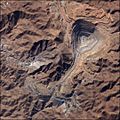Toquepala Caves facts for kids
| Location | Toquepala, Ilabaya, Tacna |
|---|---|
| Region | Moquegua Region, Andes, Peru |
| Coordinates | 17°18′16″S 70°43′05″W / 17.30444°S 70.71806°W |
| Altitude | 2,200 m (7,218 ft) |
| Type | Caves |
| Length | 10 m (33 ft) |
| History | |
| Material | Sandstone |
| Site notes | |
| Public access | Yes |
The Toquepala Caves are a group of ancient caves found in the southeast of Peru. They are famous for their amazing rock paintings, which are some of the oldest artworks in the Americas! One of the most well-known caves is called Abrigo del Diablo, which means "Devil's rock face". These caves are located about 154 km (96 mi) from the city of Tacna, close to the Toquepala mine.
Contents
Where are the Toquepala Caves?
The Toquepala Caves are nestled high up in the western Andes mountains of Peru. They are part of the Moquegua Region, near the Osmore River. The caves are found at an elevation of about 2,200 m (7,200 ft) (or 7,200 feet) above sea level.
There are two main caves, each measuring about 15 m × 5 m (49 ft × 16 ft) (about 49 by 16 feet) and 5 m (16 ft) (16 feet) deep. They are located near a dry stream called the Quebrada Cimarron or along the Rio Locumba.
A Glimpse into the Past: History of the Caves
The Toquepala Caves were used by ancient people who lived there at different times of the year. The amazing rock art found inside was created when the Collawa people lived there during the Paleolithic or Stone Age period.
How the Caves Were Discovered
These important caves became well-known after copper was found in the valley nearby. The South Peru Copper Corporation began exploring the Cuajone mine in the area. During their mining work, they found many old objects and decided to fund a study of the cave paintings.
In 1963, a team of archaeologists from Lima began studying the caves. This team was led by Jorge C. Muelle, who was the Director of the Museo Nacional de Arqueología, Antropología e Historia del Perú (National Museum of Archaeology, Anthropology, and History of Peru). They discovered the incredible rock art, also known as rupestral art.
Exploring the Caves
More detailed exploration of the caves was done by Roger Ravines in 1965. He was also from the National Museum. He dug a pit about 1.8 m (5 ft 11 in) (6 feet) deep. Scientists used a method called radio carbon testing on what he found. This showed that people lived in the caves around 7,650 BC, which is about 9,600 years ago! Some sources even suggest it could be as old as 10,000 BC.
In one part of the pit, they found pieces of paint and wooden brushes at the same depth. This helped them understand how the ancient artists worked. Roger Ravines published his findings in 1965.
To protect the precious rock paintings, a fence was put up around the caves. However, some people still managed to get in and damage parts of the art. Because of this, stronger security fences have been added to keep the paintings safe.
What Makes the Caves Special?
The Toquepala Caves are famous for their rock art, which was made by hunter-gatherers who lived there about 10,000 years ago. There are more than 50 rock paintings in the caves. Scientists have studied 30 of them in detail.
What the Paintings Show
The paintings show scenes of people hunting animals. The main animals shown are guanacos, which are a type of camel-like animal found in the Andes. The pictures show humans working together to trap and kill groups of guanacos.
The human figures are shown attacking the animals with tools like axes, lances, and spear throwers. Interestingly, there are no bows and arrows in these ancient paintings.
Colors and Materials
The artists used seven different colors for their paintings. Red was the most common color, but yellow and green were also used. The paint was made from a mineral called hematite, which is a type of iron ore.
See also
 In Spanish: Cuevas de Toquepala para niños
In Spanish: Cuevas de Toquepala para niños




